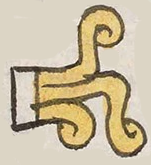nahuatl (Mdz51r)
This element has been carved from the compound sign for the place name, Yaonahuac. In this group of speech scrolls, the curling parts go to the right, but they turn both up and down. Also in contrast to most others in this collection, this one has three curling parts, and, instead of being painted turquoise, they are yellow. They also have a white, vertical, rectangular base from which they emerge. They are not emerging from a mouth in this case.
Stephanie Wood
We know from the gloss for the original compound glyph that the stem for this atomic is "nahua" (and the final locative suffix is not shown). But if this were an ideograph, other vocabulary of relevance could be tlahtoa (to speak) and tlatolli (word). Ian Mursell's Mexicolore website devotes a page to the speech scroll, referring to it as a spiral-shaped volute. That page also includes many examples of speech scrolls from Nahua and Mixtec manuscripts. Also, it is worth noting that glyph expert Katarzyna Mikulska reviewed the Mexicolore page.
The curling of the sound implies movement. Also, the scrolls make sound visible. In the original compound glyph from which this element comes, nahuatl played a phonetic role, representing the locative suffix -nahuac, located near or next to.
Stephanie Wood
c. 1541, or by 1553 at the latest
Stephanie Wood
speech scrolls, volutas

nahua(tl), speech or an agreeable sound, https:nahuatl.wired-humanities.org/content/nahuatl
pleasant sound
las volutas, el lenguaje, un sonido agradable
Stephanie Wood
Codex Mendoza, folio 51 recto, https://digital.bodleian.ox.ac.uk/objects/2fea788e-2aa2-4f08-b6d9-648c00..., image 112 of 118.
The Bodleian Libraries, University of Oxford, hold the original manuscript, the MS. Arch. Selden. A. 1. This image is published here under the UK Creative Commons, “Attribution-NonCommercial-ShareAlike 3.0 License” (CC-BY-NC-SA 3.0).




